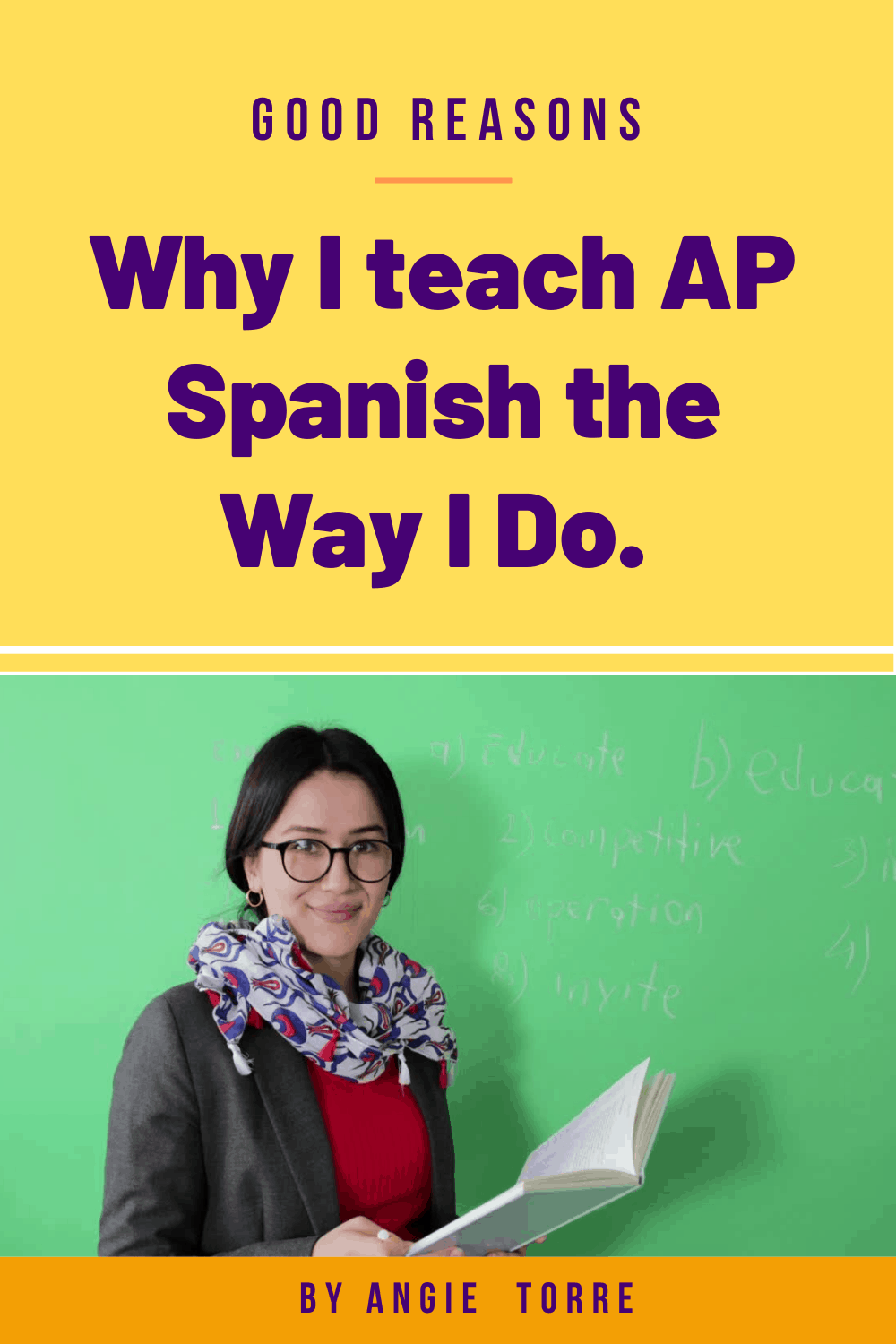Good Reasons Why I Teach AP Spanish the Way I Do
Many users of my AP Spanish Language and Culture Lesson Plans and Curriculum have asked me questions about why I teach AP Spanish the way I do. There are reasons for my madness. In this post, I will answer those questions.
1. Why do you begin with the theme, “La vida contemporánea instead of “Las familias y las comunidades” like the College Board does?
Before teaching AP Spanish, I read every article and listened to every audio in the Triángulo aprobado and Vista Higher Learning test-prep booklets. Ditto for the Temas book. As I was reading them, I realized my students were going to struggle with the advanced vocabulary. Since they were also taking other rigorous classes, they tended to drop Spanish in favor of the other classes if it appeared too difficult initially.

In order to keep students in the class, I did two things: First, for the first two weeks, I assigned fun activities and achievable tasks.
Second, I chose the theme with the least challenging vocabulary and the most relevant, interesting topic, “La vida contemporánea.” Even though I pre-teach the difficult vocabulary so students are familiar with it before they encounter it in the readings, they still feel overwhelmed if there are too many words they don’t understand.
However, if the topic is interesting enough to them, they are more likely to persist even with challenging vocabulary. The theme of Contemporary Life addresses such issues as, “education, lucrative careers, chatting, stereotypes, recycling, healthy lifestyle, lifestyles in general, parent-child relationships, personal relationships, and traditions,” topics of high interest to the students.
The lesson plans and curriculum along with the test-prep booklets, novels, and Repaso Grammar book are all you need to teach the class so you don’t need to use the resources on the College Board. One of the benefits of using this curriculum is it makes all the decisions for you so you don’t have to search for and choose resources to use. Of course, you can modify the lessons and substitute activities if you like. But you don’t need to.
THE SYLLABUS
You may have noticed the syllabus begins with the theme, “Las familias y las comunidades.” Since the syllabus must be submitted to the College Board for approval, it begins with the same theme as the College Board materials. The syllabus serves to show the CB examples of the activities you will be using. Once you submit it, forget it. Use the Table of Contents as a reference to help guide and pace you through the materials.
2. How do I navigate through all the curriculum? I feel overwhelmed.
First of all, there appear to be more files than there are because many resources are in two places. So, you can breathe a sigh of relief: It only LOOKS like there is a mountain of materials.
For example, the homework is in two places. Since everyone’s class periods are a different length of time, teachers need to be able to assign the homework when students are ready for it, not when the lesson dictates it. Also, each group of students is different, and classes will take different amounts of time to complete tasks. In addition, a teacher with a shorter class period will not want to assign a task that students have not yet practiced. Therefore, the homework is at the end of each day’s lesson plan as well as in its own folder, in order of when it is assigned.
How to Navigate the Curriculum
- Begin by going to “Read First.” There you will find instructions for how to get support, teaching tips, supplementary resources needed, inexpensive places to buy them, and more.
The culture projects are also in two places.
- Skim the Table of Contents and refer to it often in order to help you pace and find when concepts, themes, and subthemes are taught.
- Use the color legend to determine which book or source the pages are referring to. For example, the lesson may say,
“Repeat vocabulary in context for Fuente número 2 p. 118 (44-50). Use the vocabulary packet.”

Because the page numbers are green, you will know they are referring to the vocabulary packet.
Find what you need quickly in the daily lesson plan folders. Everything you need for each day’s lesson is in the folder for that day. Look on the left of the lesson, where it says, “Need” to see what you will need. This way, you don’t have to go looking for anything. EXCEPT the PowerPoints and novels. They are in their own folder because they are repeated in multiple lessons and the PowerPoint files are too large to house in more than one place.

3. If I have the old version of Vista Higher Learning test-prep booklet, can I still use your lesson plans to teach AP Spanish?
Yes, you can. There are not that many changes in the updated version and I have included a list of those changes. If you still have the black book, look at the folder that says “VHL Changes” to see what articles and audios have been replaced. You can decide to find similar articles online or in other sources and create your own questions and activities, or you can omit the replaced articles and use only the ones provided in my curriculum.
4. If my school is not on the block schedule or my period length is different, can I still use your lesson plans to teach AP Spanish?
Yes. Follow the lesson plans in order, stopping at the end of your class period and beginning again the following day where you left off. Use the homework folder to assign homework rather than the “independent practice” at the end of each lesson.
5. Why don’t you go in order in the Vista Higher Learning booklet? Why do you jump around?
The VHL Exam Preparation booklet is divided by sections of the test, Interpretive Print Texts, Interpretive Print and Audio Texts, Interpersonal Writing, Presentational Writing, Speaking Conversation, and Presentational Speaking, NOT by theme or topic.
I think it’s easier for students to hop from page to page than to hop from topic to topic. If they stay on the same topic for a length of time, they will internalize the vocabulary and related expressions better as they discuss similar themes.
Also, following themes rather than exam task allows students to master each section of the test since they are practicing them concurrently and for more time.
6. How many of the activities are based on the Temas textbook? (For the Vista Higher Learning Lessons)
Most of activities are based on the exam preparation booklet for three reasons:
- Students need to spend the majority of the time practicing each section of the test.
- Most of the concepts in Temas are already included in the curriculum or in the book, “Repaso.”
- Temas is expensive. If schools cannot afford it, they can buy just the test-prep booklet.
There are some activities (maybe 10%???) based on Temas. So, if your school already has the book, yay! If not, you can omit those.
7. Do I have to teach novels? Do I have to buy the novels included in your lessons?
No, you can buy any novels you like or leave them out. If you buy others, you will have to create your own vocabulary lists and quizzes. If you omit the novels, students will not get non-fiction vocabulary and could get weary reading only non-fiction with advanced vocabulary. (My brain, my brain!)
8. What other materials do I need in order to use the curriculum?
There is a list of required materials at the bottom of the product description as well as in the “Notes to the Teacher” in the “Read First” folder. However, I will list them below, also.
The list below is for the AP Spanish Language and Culture Vista Higher Learning Lesson Plans and Curriculum. For the Triángulo lesson plans, “b” would be “Triángulo aprobado, Manual para estudiantes,” ISBN: 978-1-938026-41-6 and “Manual para profesores,” ISBN: 978-1-938026-43-0 and you would omit “Temas.”
Resources needed to use this curriculum:
- REPASO, A Complete Review Workbook for Grammar, Communication, and Culture published by National Textbook Company. ISBN: 0-8442-7412-7
- *Vista Higher Learning AP Spanish Language and Culture Exam Preparation booklet (See ISBN # below.)
- *Temas by Vista Higher Learning or another book that has short stories. (See ISBN # below). *This book is OPTIONAL. It may be omitted if there are budgetary constraints. You can replace the assignments with other short stories and accompanying activities.
- Novels for each student:
Marianela por Benito Perez Galdos (La adapción de la obra); ISBN: 84-294-3433-X
Cajas de cartón por Francisco Jiménez; ISBN-13: 978-0-618-22616-0
La tierra del tiempo perdido por José María Merino ISBN: 0-8219-1119-8
Senderos fronterizos por Francisco Jiménez; ISBN-13: 978-0-618-22618-4
(Marianela and Cajas de cartón are read simultaneously and by different students depending on level of ability.)
9. Can I contact you if I have questions?
Not only can you contact me (I come with your purchase) you can also collaborate with and get support from other teachers in the Todos preparados Facebook group who are using the same curriculum. It’s like having your own mentor teacher!
When I started teaching AP Spanish, I called the previous AP Spanish teacher almost daily. I know what it’s like. Here is my email address if you have any questions: [email protected]
10. Do I need to buy online access as well to teach AP Spanish?
The answer to this was yes until COVID hit. It’s still yes, but I have been told (not verified by experience yet) that you can buy ONE online access and share it with your students virtually.
The best answer though, is that the teacher and every student need online access in order to be able to hear the audios and to access certain activities. The hardest part for students to master is the audio comprehension and they need lots of listening practice. See THREE TIPS FOR TEACHING AP SPANISH LANGUAGE AND CULTURE
If you would like to see what I am talking about visually, take a look at this short video. (AP Spanish begins at 29:37. The part before addresses the year-long lesson plans and textbooks for Spanish One, Two, Three, and Four.)
I hope this post has answered some of your questions about why I teach AP Spanish the way I do and helps you navigate the curriculum if you purchased the AP SPANISH LESSON PLANS AND CURRICULUM FOR AN ENTIRE YEAR. If you have any questions I have not addressed, please email me and I will give you my best answer. My email is [email protected]
If you haven’t purchased the AP Spanish Lesson Plans and Curriculum, you may be spending too much time writing lesson plans and looking for materials. This curriculum does everything for you! All you do is teach and correct. (And there’s a TON of correcting in AP Spanish.) Join hundreds of teachers who spend less time preparing and more time watching their students succeed on the AP exam. Click on the following links to see what others say about this curriculum.
TESTIMONIAL BELOW
Don’t miss out on freebies! Make sure to follow my STORE in order to get notified of updates on products, free resources, and new products.
Happy teaching!
If you would like to receive these blog posts with teaching tips and freebies in your email, subscribe to my monthly newsletter, BestPowerPointsforSpanish.
Just scroll down to the bottom and click, “Sign up.



How much is the AP Spanish lesson plans and curriculums
Hi, Isidro: The AP Spanish Lesson Plans and Curriculum for Triángulo aprobado are $217.50. The AP Spanish Lesson Plans and Curriculum for Vista Higher Learning are $228.75.
Let me know if you have any other questions. You can also email me at [email protected]
Angie